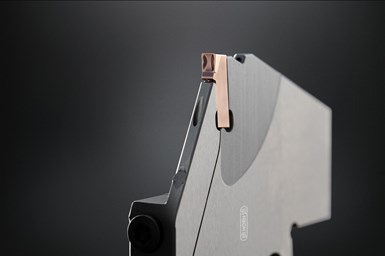Horn EH Geometry for Grooving System Enables Parting Off at High Feed Rates
Appears in Print as: 'EH Geometry for Grooving System Enables Parting Off at High Feed Rates'
The stable cutting edge of the EH geometry ensures reliable chip evacuation and control.
Edited by Angela Osborne

The EH geometry ensures reliable chip evacuation and control.
Horn’s EH geometry for its S100 grooving system enables parting off at high feed rates. The stable cutting edge enables feed rates in the range of f= 0.25-0.4 mm/rev during grooving and parting off, which results in reduced machining time across multiple operations.
The company says that reliable chip evacuation and control is ensured by a special chip formation. High feed rates require a stable machine when grooving and parting off, as well as secure clamping of the workpiece. Starting from a feed rate of 0.3 mm/rev (0.012" /rev), Horn recommends reducing the infeed for the first 3-4 mm (0.118"- 0.157") during grooving and parting off. Due to their stability, holders and cassettes are often the first choice when grooving along the Y axis. Horn offers the single-edged grooving inserts in widths of 3 mm (0.118") and 4 mm (0.157").
In 2019, Horn expanded the S100 grooving system by adding new holder variants for grooving on turn-mill centers with the feed along the Y axis. The process enables high-performance parting off with high cutting values, resulting in a shorter machining time. These holder variants offer the ability to part off large diameters using a compact holder as well as parting off with narrower widths.
Substantial cutting forces are generated while parting off large diameter workpieces. The available space inside machines often does not allow the use of large cross-section tools. The toolholder’s new insert arrangement enables the cutting forces to be absorbed by the main cross section of the part-off tool. This results in higher rigidity of the overall system for a given cross section, enabling higher feed rates for the width of insert. The transmission of force along the longitudinal direction of the tool enables narrower holders to be used to achieve the same system rigidity.
RELATED CONTENT
-
Selecting the Right Milling Tool for Any Machining Task
High-performance milling cutters combine high cutting data with long tool life and efficiency, but certain factors must be considered when selecting tools for different machining tasks.
-
Making Micro Threads
Production of micro threads can be challenging, but using the most suitable tools for a given application can simplify the task.
-
Cutting Tool Coating Production
This article looks at the coating methods available for carbide cutting tools.



